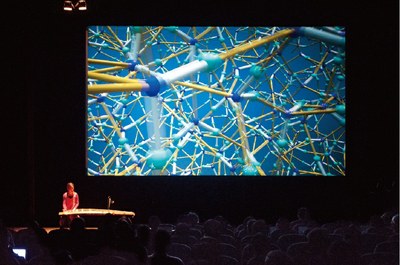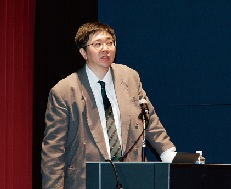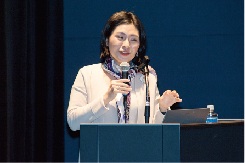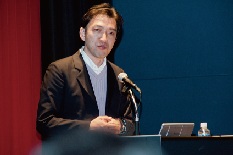Part1 Achieving Increased "Visibility"
 Society has high hopes for the materials science research of CMSI, which aims at the development of next-generation electronic devices, medicines, energy conversion materials, etc. However, atoms and molecules that make up materials cannot be seen by the naked eye, and thus the computational materials science that endeavors to discover the behavior of materials through the large-scale computing is said to be too difficult to understand. How can we convert social expectation into interest? We will search for a path to "visibility" based on the discussions and proposals at the 1st Computational Materials Science Visualization Symposium in March 2013, organized jointly by Toyohashi University of Technology and CMSI.
Society has high hopes for the materials science research of CMSI, which aims at the development of next-generation electronic devices, medicines, energy conversion materials, etc. However, atoms and molecules that make up materials cannot be seen by the naked eye, and thus the computational materials science that endeavors to discover the behavior of materials through the large-scale computing is said to be too difficult to understand. How can we convert social expectation into interest? We will search for a path to "visibility" based on the discussions and proposals at the 1st Computational Materials Science Visualization Symposium in March 2013, organized jointly by Toyohashi University of Technology and CMSI.
"Increased Visibility for People" A Primary Focus of CMSI
The move to make science more "visible" can be thought of as one part of public relations activities. Naturally communicating scientific achievements to society at large is important, but for CMSI there are other important targets as well. These include theoreticians, experimentalists, researchers in other fields and private companies, as entrances and exits of materials science research, as well as high school and undergraduate students and people in charge of hiring at companies and research institutes, as potential sources and export markets of instituhuman resources.
What kinds of things should be made "visible" in public relations activities? First and foremost are the achievements of computational materials science. Normally these are released in the form of academic papers, conference presentations and patents. For the general public and high school students, however, the publicity should include not only research outcomes but also the things that make computational materials science interesting and the views of the researchers: What they were interested in and why they conducted their research. In addition, the software programs that have been developed at CMSI and the experience and information that have been accumulated in the course of parallelization and optimization are also important CMSI assets. Publishing these assets and working to disseminate them both within the field and to other fields will also play a publicity role. Finally, public relations activities about the young researchers who are engaged in research and development within CMSI will also be essential for creating career paths and providing stimulation to the field.
CMSI is currently putting its energies into a variety of activities. The first is the establishment of a "Division Researcher" system. (This was featured in Torrent No. 3.) CMSI is a network-style community that has 14 Divisions in Japan as well as various institutional participants. For this type of organization, a function is needed to gather together the experience, information and knowledge accumulated at each location, and then make it the common property of the field of computational materials science and disseminate it within that field. This is the mission of the Division Researchers. The educational activities that are conducted for the benefit of graduate students and young researchers are also taking new forms such as distance learning (Part 2 of this Special Topic).
The second effort for making computational materials science more visible is the newsletter you're reading right now. Torrent has featured special reports on major topics such as CMSI research achievements, application development, educational activities and so on. In these articles, young researchers, application developers, teachers, graduate students and other persons appear as writers or interview subjects, and the articles do not focus only on research achievements but also make an effort to make these people more visible. As Torrent sees it, the first step in achieving increased visibility is finding ways to get people to pick up the newsletter. For this reason, we publish it in hard copy form, and we made the cover design bright and colorful, as electrons and molecules may strike people as cold and remote.
CMSI is also working to make applications more visible. Up to now, the tendency has been to not consider application development to be research, and for this reason the face of the developers has hardly been seen. CMSI not only publishes applications but also goes out of its way to introduce the developers of those applications. CMSI is also working to form a community made up of the theoreticians, experimentalists and company people who use our applications.
"Communicating Correctly" to Ensure "Understanding"
Many proposals were made by the invited speakers at the Computational Materials Science Visualization Symposium.
Tomoyoshi Ito (Professor of Engineering Research, Graduate School of Engineering, Chiba University) is a researcher who is studying 3D images that use holography. He noted that human vision is very severe when it comes to the quality of still images, and the low resolution of a still image bothers us. But we are very tolerant when it comes to moving images, and we will accept them as long as the content is interesting, and he proposed that moving images be used in an effort to increase visibility. However, he also pointed out that, while increasing "visibility" is certainly an effective method with respect to the general public, it may actually have the reverse effect on specialists. The essence of science is to seek things that are not well understood, so the more difficult it is to see something, the more researchers are intrigued by it and the more they want to start investigating.
Hiromi Yokoyama (Associate Director, Office of Communication, School of Science, The University of Tokyo) spoke on the question of "what is the excitement?" by introducing the words by Zeami, "It is because it is hidden that the flower is een as beautiful; it would not be seen as beautiful if everything was revealed." She says researchers should first determine exactly what it is that they want people to understand. At some times and in some situations, they must make a choice between presenting a complete picture or ranking things in terms of what is most important, and emphasizing spatial relationships or focusing on mechanisms. Through this process, they will narrow down the content that they are communicating, enabling the listener to understand it fully.
"Understanding and Intuition" was the title of the presentation by Hideki Uematsu (Director, NHK Nagoya Broadcasting Station). He said that his motto is to get people to understand things intuitively. He said that what is needed in order to accomplish this is "déformer." He says "déformer" can make difficult topics easier to understand. As an example, he presented an NHK Hi-Vision Special entitled "People Under the Spell of Prime Numbers: The 150-year Struggle of the Geniuses Behind the Riemann Hypothesis." Mr. Uematsu said it is simply not possible to get people to understand everything about the world of abstract mathematics. So in the early part of the program, the mathematician Euler was shown single-mindedly continuing to climb stairs made of prime numbers, even in the face of fierce winds and driving rain. These stairs were modeled on a basic graph depicting how many prime numbers are distributed among the natural numbers (in other words, the prime number theorem). Mr.Uematsu said he introduced this image as a visual depiction of the hard work and enthusiasm of Euler, who calculated by hand the prime numbers up to the hundred thousand, and as something that could communicate the irregular nature of prime numbers. As Mr. Uematsu had anticipated, this scene took hold as a key image of the program, and it enabled viewers to get a sense of prime numbers. "Déformer" does not simply make difficult concepts easier to understand; it also provides depth to easy-to-understand concepts and helps to make this depth interesting. This concept of "déformer" will be a major strategy for achieving visibility.
Making Science Enjoyable
One thing that the invited speakers were unanimous in emphasizing was that an effort should be made to communicate the romance, the dreams, and the fascinating aspects of science.
Once scientific achievements are put out into the world, they become mundane. But a history of the events leading up to that point exists. Surely there are passionate human dramas contained in that history. Professor Ito used holography as an example to explain that there is a century of human history that extends from Max Plank, the discoverer of quantum mechanics, to the people involved in the progress leading to the development of the electron microscope, and eventually to Akira Tonomura, who studied electron beam holography.
To Mr. Uematsu, who produces science programs, making the content interesting means everything. If viewers find the content even a little difficult or impossible to understand, they will not watch the program. So he conducts interview after interview with researchers, creates video images, and spins a narrative. In the production of the aforementioned program about prime numbers, he asked the researcher "Why are prime numbers so important?" But instead of the difficult-tounderstand answer that he was expecting, he got an unexpected reply. "Prime numbers are all around us," the researcher said. "You just can't see them." From that reply, he was able to create scenes depicting numbers running through the desert and projected on the surface of the moon. Mr. Uematsu points out that, even though researchers take them for granted, there are often aspects that seem quite wondrous to the general public. So he proposed that CMSI researchers explain their research by comparing it to things in the world around them, and he also suggested that they talk about it to the people around them and watch the reaction.
Tetsuo Karaki (Director, Office for Research Communication, RIKEN AICS), who had participated as a panelist, said that it is important to speak from a recipient's perspective in order to get people to see research achievements as relevant to their lives. He said that this is important because researchers tend to talk from a "sender's" perspective, when what most people want to know is how the topic is relevant to their own lives.
Mr. Uematsu also pointed out that the reason that Japanese researchers find it difficult to communicate the romance of science is that they tend not to boast about their research. Researchers from other countries reportedly often use expressions that have a great deal of impact, such as "prime numbers are God's cyphers" and "solving this question will enable humanity to take a step forward."
 |  |  |
|
Tomoyoshi Ito gave a talk on
the theme of “Communicating
Science Interestingly by
Visualization and Scenario.”
|
Hiromi Yokoyama gave a talk on
the theme of “Can Visualization
be the Key? ̶ Strengths and
Weaknesses of Computational
Materials Science from the
Viewpoint of Other Fields.
|
Hideki Uematsu gave a talk on
the theme of“Understanding
and Intuition.”
|
The Next Step
Recently, it has begun to be necessary for researchers to talk about their research in their own words. For this to happen, a change in the awareness of the researchers themselves is needed. To communicate one's enthusiasm for research to people and get them to understand it, it is essential for the research to be seen as enjoyable, and the researchers themselves must think of ways to make their ork "visible." CMSI plans to conduct a variety of activities based on the proposals made at the symposium. The achievements will be introduced at the 2nd and subsequent Computational Materials Science Visualization Symposiums.
 Society has high hopes for the materials science research of CMSI, which aims at the development of next-generation electronic devices, medicines, energy conversion materials, etc. However, atoms and molecules that make up materials cannot be seen by the naked eye, and thus the computational materials science that endeavors to discover the behavior of materials through the large-scale computing is said to be too difficult to understand. How can we convert social expectation into interest? We will search for a path to "visibility" based on the discussions and proposals at the 1st Computational Materials Science Visualization Symposium in March 2013, organized jointly by Toyohashi University of Technology and CMSI.
Society has high hopes for the materials science research of CMSI, which aims at the development of next-generation electronic devices, medicines, energy conversion materials, etc. However, atoms and molecules that make up materials cannot be seen by the naked eye, and thus the computational materials science that endeavors to discover the behavior of materials through the large-scale computing is said to be too difficult to understand. How can we convert social expectation into interest? We will search for a path to "visibility" based on the discussions and proposals at the 1st Computational Materials Science Visualization Symposium in March 2013, organized jointly by Toyohashi University of Technology and CMSI.



